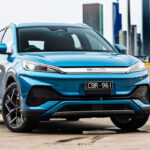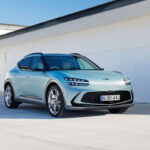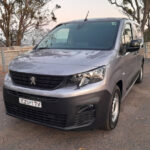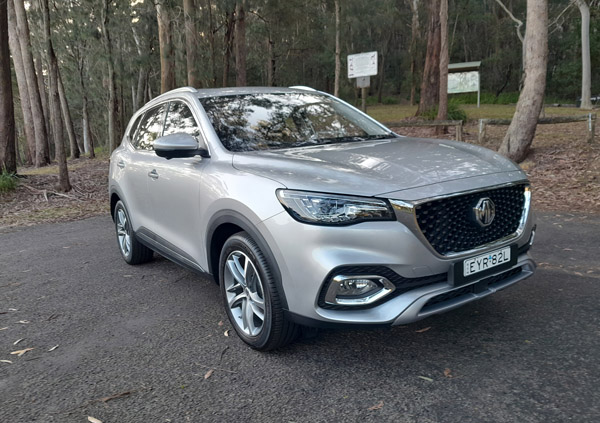
The MG HS +EV is a mid-sized SUV from the Chinese manufacturer that is making such
an impact on the Australian market.
The name can be a little misleading because it’s not fully-electric but rather a plug-in
hybrid (PHEV) and so comes with a petrol engine together with a battery that can be
charged in the same manner as an EV.
Plug-in hybrids are an excellent concept but in practice, at least at this stage of their
development, they don’t make a lot of sense. Firstly, they are typically at least $10,000
more expensive as their petrol-only equivalents.
Secondly, because they use relatively small batteries, the EV-only range is quite low and
once the battery has expired, they just become another hybrid but a tad heavier due to the
battery.
The MG HS +EV competes against similarly-sized PHEVs such as the Mitsubishi
Outlander, Ford Escape and the just-released Mazda CX-60. With driveaway prices
starting at $49,690 it’s the cheapest of the four and comes with the longest (seven-year)
warranty.
MG HS +EV comes in two variants, Excite and Essence. The latter was our test vehicle
vehicle.
STYLING
MG HS +EV is a neat and conservative vehicle without anything to make it stand out from
the SUV crowd. The front is dominated by a large honeycomb grille with the familiar ‘MG’
badge at front-and-centre. We often wonder how many buyers, especially younger ones,
recognise that iconic badge and its history – we suspect not many.
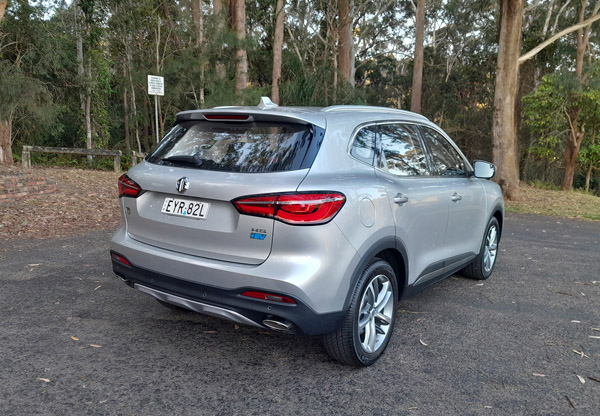
The grille then flows into wide, narrow headlamps with daytime running lights above
extended lower air vents, also honeycombed.
The Essence variant comes with 18-inch diamond cut alloy wheels, LED headlights, front
foglights, puddle lights that project the MG logo onto the ground and a panoramic glass
sunroof with a sunshade.
Excite only gets halogen headlights and 17-inch alloys.
Four body colours are available, all metallic: Pearl White, Sterling Silver, Black Pearl and
Diamond Red.
INTERIOR
HS +EV is a good size, with large comfortable seats, plenty of rear legroom and air vents
for back seat passengers. Entry is easy to manage and there’s good interior space. Rear
legroom is acceptable and there’s plenty of headroom despite the Essence’s panoramic
sunroof.
Excite comes with polyurethane / PVC seats while the Essence steps up to two-tone
leather front sports seats with power adjustment and heating as well as LED ambient
lighting.
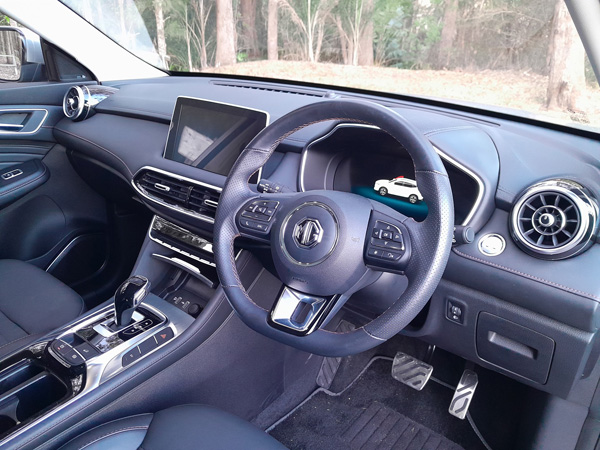
Boot space is a reasonable 451 litres with the rear seats in place and expands to 1275
litres with the seatbacks folded. Essence comes with a powered tailgate. The battery
charging cable is stored below the boot floor meaning that there’s no room for a spare
wheel, instead you’ll need to rely upon the supplied tyre repair kit if you get a puncture, a
growing risk in pot-hole riddled Eastern Australia.
The boot is shallow but offers a reasonable 451 litres rear seats up and 1275 litres with the
seat backs folded. The Type 2 charge cable is stored under the boot floor where it doesn’t
get in the way, but also leaves no room for a spare wheel (a reinflation kit is provided).
POWERTRAIN
Power comes from a 1.5-litre 119 kW / 250 Nm turbo-petrol engine, together with a
16.6kWh battery pack and 90kW electric motor that combine to provide an impressive
combined output of 189kW and 370Nm.
It is mated to a 10-speed EDU II automatic gearbox, which consists of six-speed auto for
the internal combustion engine and four-speed electronic drive unit.
All-wheel drive is available in the petrol-only HS but, at this stage, the +EV is front-wheel
drive only.
Battery charge time is listed at around seven hours from a normal household socket. We
were able to charge from empty to full in just under four hours from our home 7kW
JetCharge wall box.
INFOTAINMENT
Inside there are two large screens, a 12.3-inch fully digital instrument cluster with built-in
satellite navigation and a 10.1-inch multi-function high-definition infotainment colour touch
screen with large user-friendly displays.
The twin information screens are easy to read and operate although, as is becoming
increasingly common, too many of the most-used features needed screen taps rather than
through physical knobs.
Smartphone mirroring is available through cabled Apple CarPlay or Android Auto with two
USB ports at the front and another pair at the rear. Satellite navigation is standard in both
variants.
The big touchscreen is impressive and provides sharp and clear vision through the
reversing camera.
One side of the digital instrument cluster is devoted to the petrol engine, while the other
keeps you up to date on the battery level as well as how much assistance the electric
motor is providing – with three figures for consumption across the bottom.
Both variants get the same six-speaker 3D surround sound audio system.
SAFETY
The HS PHEV is yet to receive an ANCAP crash rating but the petrol variants were tested
in 2022 and received the maximum five stars.
Standard safety features in both variants include six airbags; enhanced ABS brakes;
electronic stability program; active cornering brake control; front seat impact absorbent
door padding; hill start assist; emergency automatic door unlocking and hazard light
activation; tyre pressure monitoring; reversing camera; and rear parking sensors.
Essence adds a 360-degree surround-view camera.
Both models also come with the MG Pilot package which adds enhanced features such as
adaptive cruise control; forward collision warning; automatic emergency braking; lane
departure warning; traffic jam assist; intelligent cruise assist; blind spot warning; rear cross
traffic alert; intelligent headlamp control; and speed assistance system.
DRIVING
As with most hybrids the HS +EV takes off using the battery but once under moderate
acceleration the petrol engine takes over. Unlike some others though it is possible to drive
purely under battery power by tapping the ‘EV’ button on the centre console which ensures
that the engine doesn’t activate while ever there is charge in the battery.
Fuel consumption is listed at 5.8 litres per 100 kilometres under the city cycle but drops
down to just 1.7 L/100 km on the combined city/highway cycle.
Note that it does need 95 RON premium fuel and charging with a standard power point
takes about seven hours using a standard 10A power point.
Maximum range under battery-power alone is a claimed 63 kilometres so the only way to
get even close to the 1.7 L/100 is to stop the car every 100km and fully recharge the
battery before heading off again. Not a very practical scenario.
Midway through our week in the HS +EV we did a specific test entirely in EV mode with
the battery fully charged. We chose the flattest available route and with conservative
driving he got close to the 63 kilometre distance.
At the other end of scale we tested the fuel consumption with no charge in the battery and
averaged 6.9 L/100km on our predominantly motorway drive from Gosford to Sydney
helped along by the usual brake regeneration feature of most hybrids.
These issues aside we found the plug-in MG to be a pretty impressive vehicle. The instant
torque and silent running of EVs contribute to a very enjoyable driving experience. There’s
little or no excitement, but that’s the norm with vehicles at the smaller end of the SUV
segment. Steering is a bit on the heavy side but responsive enough.
The amount of brake regeneration when decelerating cannot be adjusted but we found
that the level was just right, effective without being too intrusive.
The steering is okay but doesn’t provide a lot of feedback and the same can be said of the
brakes which could do with more feel.
SUMMING UP
Whether the extra $10k for the +EV over its petrol-only HS equivalents can be justified will
depend on buyer’s individual circumstances. For urban buyers with short distance
commutes and a home fast-ish wallbox it would make sense.
At around $50k the price is not that much less than mainstream offerings from the
Japanese, principally Toyota’s best-selling RAV4 Hybrid, which although it is not a plug-in
does provide excellent fuel economy.
Importantly, with long waiting times for most of its competitors – including the
aforementioned RAV4 – buyers can get into most MG models within weeks rather than
waiting many months.
AT A GLANCE
MODEL RANGE
HS 1.5 Vibe 2WD: $32,990
HS 1.5 Excite 2WD: $35,990
HS 2.0 Excite X AWD: $38,990
HS 1.5 Essence 2WD: $39,990
HS 2.0 Essence X AWD: $43,990
HS 1.5 Essence Anfield: $41,690
HS +EV 1.5 Plug-In Hybrid Excite 2WD: $49,690
HS +EV 1.5 Plug-In Hybrid Essence 2WD: $53,690
Note: These are drive-away prices and include all government or dealer delivery charges.
SPECIFICATIONS (MG HS +EV Essence 1.5-litre petrol / electric plug-in hybrid five-door
wagon)
ENGINE / BATTERY:
Capacity: 1.490 litres / 1.8 kWh
Configuration: Four cylinders in line
Combined Maximum Power: 189 kW
Combined Maximum Torque: 370 Nm
Fuel Type: Premium unleaded petrol
Combined Fuel Cycle (ADR 81/02): 1.7 L/100km (see text)
CO2 Emissions: 39 g/km
DRIVELINE: 10-speed automatic (combined engine and battery)
DIMENSIONS, WEIGHT AND CAPACITIES:
Length: 4574 mm
Wheelbase: 2720 mm
Width: 1876 mm
Height: 1685 mm
Turning Circle: Not supplied
Kerb Mass: 1775 kg
Fuel Tank Capacity: 55 litres
BRAKES:
Front: Ventilated disc
Rear: Solid disc
STANDARD WARRANTY:
Seven years / unlimited kilometres
RATINGS
Looks: 8/10
Performance: 7/10
Safety: 8/10
Thirst: 9/10
Practicality: 8/10
Comfort: 8/10
Tech: 7/10
Value: 7/10




